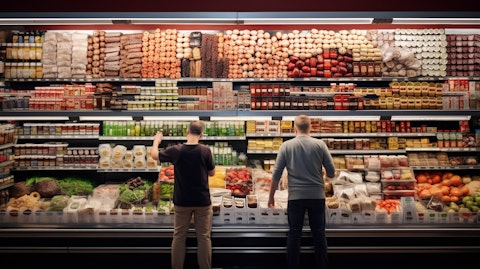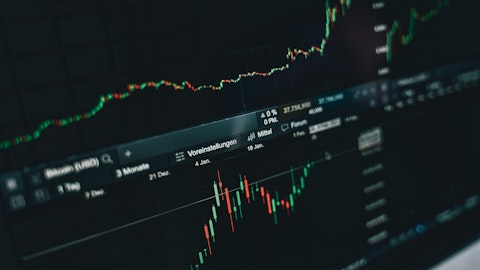In this article, we will take a look at some of the best food dividend stocks, according to analysts.
The US food industry continues to evolve as consumer habits shift and environmental challenges increase. Leading food companies tend to have powerful brands that encourage shoppers to pay premium prices while their scale helps them manage costs efficiently. In today’s inflationary environment, having both pricing power and cost advantages is crucial as households face tighter budgets and rising supply chain expenses.
Food prices are among the most unpredictable expenses for households, often fluctuating because of factors like extreme weather, disease outbreaks, and global supply issues. These factors have all contributed to higher prices over the past year. Although prices stayed flat between June and July, they were still 2.9% higher than the year before, exceeding the Federal Reserve’s 2% inflation goal, according to the Bureau of Labor Statistics’ Consumer Price Index.
Not all food categories are seeing steep price hikes, but consumers are still feeling the impact of years of inflation. Since 2020, food costs have risen by roughly 26%, based on CPI data.
Chedly Louis, vice president of corporate finance at Moody’s Ratings, noted that while inflation has cooled from the record levels of two years ago, food prices remain well above pre-pandemic levels.
As an essential consumer product, food remains in steady demand, making the sector relatively resilient and often a safe haven for investors during economic slowdowns. Given this, we will take a look at some of the best food dividend stocks according to analysts.

Our Methodology
For this list, we scanned Insider Monkey’s database of Q2 2025 and picked dividend companies belonging to different segments within the food industry, such as food manufacturers, food processors, beverage companies, and restaurants. We analyze these companies through their financial health and dividend policies. From that group, we further refined our selection criteria by identifying stocks with a projected upside potential of over 5% based on analyst price targets, as of October 5. The stocks are ranked according to their upside potential.
Why are we interested in the stocks that hedge funds pile into? The reason is simple: our research has shown that we can outperform the market by imitating the top stock picks of the best hedge funds. Our quarterly newsletter’s strategy selects 14 small-cap and large-cap stocks every quarter and has returned 373.4% since May 2014, beating its benchmark by 218 percentage points (see more details here).
14. General Mills, Inc. (NYSE:GIS)
Analyst Upside Potential as of October 5: 6.7%
General Mills, Inc. (NYSE:GIS) is one of those companies that’s been around so long, most people don’t even realize how many of their favorite brands it owns. From Cheerios and Pillsbury to Häagen-Dazs, Progresso, Yoplait, and Green Giant, its products cover just about every aisle in the grocery store.
Lately, higher inflation and a shaky economy have been changing the way people shop. General Mills, Inc. (NYSE:GIS) seems well aware of that and has been trying to adjust by cutting prices here and there, running more promotions, and finding ways to remind customers that their brands still offer good value.
Sales have taken a bit of a hit, especially in snacks, and profits aren’t quite as strong as they used to be. Even so, General Mills, Inc. (NYSE:GIS) remains comfortably in the black and continues to stick by its dividend, which investors appreciate. One part of the business that could see real growth in the years ahead is pet food. Since buying Blue Buffalo back in 2018, the company has been expanding that segment steadily, and it’s shaping up to be a long-term winner.
General Mills, Inc. (NYSE:GIS)’ 127-year track record of regular dividends has always grabbed investors’ attention. On September 29, the company declared a quarterly dividend of $0.61 per share, and as of October 5, it has a dividend yield of 4.85%.
13. McDonald’s Corporation (NYSE:MCD)
Analyst Upside Potential as of October 5: 7.2%
McDonald’s Corporation (NYSE:MCD) has come a long way from its early days as a small burger stand in Southern California. Today, it’s a global icon with more than 44,000 restaurants spread across over 100 countries — a scale few brands have ever matched.
In tougher economic times, McDonald’s Corporation (NYSE:MCD) often finds itself in a stronger position. When people start tightening their budgets, the company’s value meals become an easy choice. It has been leaning into that trend again, putting affordability front and center on its menu, and customers seem to be responding.
Looking ahead, McDonald’s Corporation (NYSE:MCD) is planning to invest heavily in artificial intelligence. The goal is to use AI to sharpen efficiency and make its already-successful franchise model even more profitable. With operating margins comfortably above 45% and per-share earnings up 12% in the latest quarter, the company looks well placed to keep raising its dividend payouts.
McDonald’s Corporation (NYSE:MCD) already holds a 48-year track record of consistent dividend growth. This means that the company is just two years away from becoming a Dividend King. Its quarterly dividend currently sits at $1.77 per share for a dividend yield of 2.35%, as of October 5.
12. Hormel Foods Corporation (NYSE:HRL)
Analyst Upside Potential as of October 5: 8.13%
Hormel Foods Corporation (NYSE:HRL), the company behind many familiar grocery staples, had a somewhat uneven performance in its fiscal third quarter of 2025. The food maker reported adjusted earnings of $0.35 per share on $3.03 billion in sales. That was slightly better than expected on the revenue side but fell short of analysts’ profit estimates, which were around $0.41 a share.
Organic sales were up 6% from a year ago, and overall revenue climbed roughly 4.5%. Even so, profits slipped about 5% compared to last year’s results. To make things tougher, Hormel Foods Corporation (NYSE:HRL)’s management issued a cautious outlook for the next quarter that didn’t do much to lift investor confidence.
For the upcoming period, the company expects revenue to land somewhere between $3.15 billion and $3.25 billion. That’s only a modest improvement from the $3.1 billion it reported in the same quarter last year. Organic sales growth is now projected to slow to a range of 1% to 4%, a clear step down from the stronger growth seen earlier in the year.
That said, Hormel Foods Corporation (NYSE:HRL)’s dividend provides a little relief to worried investors. The company has been rewarding shareholders with growing dividends consistently for the past 59 years and offers a per-share dividend of $0.29 every quarter. The stock supports a dividend yield of 4.71%, as of October 5.
11. The Kraft Heinz Company (NASDAQ:KHC)
Analyst Upside Potential as of October 5: 8.6%
The Kraft Heinz Company (NASDAQ:KHC) is one of those food companies everyone’s familiar with. Most people have at least one of their products at home, including things like Kraft Mac & Cheese or Jell-O, which have been around for ages. It’s a huge name in the packaged food world and, because people always need to eat, the business tends to stay stable even when the economy wobbles.
In the last few years, The Kraft Heinz Company (NASDAQ:KHC) has tried to zero in on a few main goals. It wants to grow more in developing markets, keep a tighter grip on what it spends for raw materials and packaging, and use its strong brands to stay competitive. A lot of that comes down to good marketing, running its supply chain efficiently, and keeping products fresh enough that people still want to buy them.
For now, most eyes are on how things are going in North America. Both management and investors have been watching sales volumes and trying to gauge whether programs like the Brand Growth System are actually moving the needle.
Though The Kraft Heinz Company (NASDAQ:KHC) isn’t much favored by investors, its dividend yield of 6.17%, as recorded on October 5, is hard to ignore. In addition, the company has been making regular dividend payments for years. Its quarterly dividend now comes in at $0.40 per share.
10. The J. M. Smucker Company (NYSE:SJM)
Analyst Upside Potential as of October 5: 9.42%
The J. M. Smucker Company (NYSE:SJM) is one of those food companies that’s just always been around. You see its brands everywhere — Folgers coffee in the morning, Jif peanut butter on the shelf, and those fruit spreads people have been buying for decades. It’s a big player in North America’s packaged food space and covers a lot of ground in coffee, snacks, and pantry staples.
The J. M. Smucker Company (NYSE:SJM)’s dividend history stands out in the food sector. The company has increased its dividends consistently in the last 24 years, which is commendable on its part. It now pays a quarterly dividend of $1.10 per share for a dividend yield of 4.06%, as recorded on October 5.
The J. M. Smucker Company (NYSE:SJM)’s plan isn’t anything too complicated. It’s trying to keep its biggest brands strong while also finding room for new products. Lately, it’s been fine-tuning what it owns, adding things like the Hostess snack business while letting go of parts that don’t really fit anymore. At the end of the day, Smucker’s success depends on a mix of things: keeping costs under control, making smart deals, and staying flexible with prices as costs shift. It still faces the usual challenges, including changing food trends, price-sensitive shoppers, and the ups and downs of raw material prices; however, that’s pretty normal for a company of its size.
9. PepsiCo, Inc. (NASDAQ:PEP)
Analyst Upside Potential as of October 5: 10.4%
PepsiCo, Inc. (NASDAQ:PEP) is an American beverage and snack company. Its beverage portfolio includes Pepsi, Mountain Dew, and Gatorade, and its food division has well-known brands such as Lay’s, Doritos, Quaker Oats, and Cheetos. The company has multiple revenue streams. Soda, water, sports drinks, energy drinks, snacks — all of that adds up. Snacks alone are more than half of what they bring in.
It’s not just the US either. Almost 40% of sales and profits come from other countries. People keep buying these products even when the economy isn’t great, so the business stays steady. In addition, the dividend makes it an appealing option for income investors.
Due to its multiple revenue options, PepsiCo, Inc. (NASDAQ:PEP) ‘s cash flow has always remained stable. This has resulted in the company growing its payouts for 53 years in a row. Currently, the company’s dividend sits at $1.4225 per share for a dividend yield of 4.01%, as of October 5.
8. Mondelez International, Inc. (NASDAQ:MDLZ)
Analyst Upside Potential as of October 5: 17.5%
Mondelez International, Inc. (NASDAQ:MDLZ) is an American multinational confectionery, beverage, and snack company. Its products include Oreos, Chips Ahoy, Cadbury chocolate, Sour Patch Kids, and plenty of other cookies, candies, and snack bars. Their products are everywhere, and it’s easy to see why they’ve become such a big name in snacking.
For people who own its stock, Mondelez International, Inc. (NASDAQ:MDLZ) has been rewarding. Over the past five years, it’s raised its dividend by more than 10% a year and bought back billions of dollars’ worth of shares, cutting down the total stock by about 15% since 2018. The company seems set on keeping that momentum, returning cash to shareholders while still expanding its lineup of popular treats around the world.
Mondelez International, Inc. (NASDAQ:MDLZ) increased its dividend in July this year and now pays a quarterly dividend of $0.50 per share. This was the company’s 12th consecutive year in which it raised its dividend. With a dividend yield of 3.19%, as of October 5, MDLZ is among the best dividend stocks to own in the food sector.
7. Starbucks Corporation (NASDAQ:SBUX)
Analyst Upside Potential as of October 5: 17.8%
Starbucks Corporation (NASDAQ:SBUX) has become more than just a coffee shop. For a lot of people, it’s part of their morning routine or a place to grab a quick treat. People see its green logo everywhere— from big city streets to small towns— and they keep going back because they know what they’re going to get.
Being such a familiar name helps. Starbucks Corporation (NASDAQ:SBUX) can charge a bit more than smaller coffee shops, and running on such a large scale helps it manage costs better than most. The company is still growing. With the “Back to Starbucks” plan, CEO Brian Niccol is finding ways to bring people back into stores and keep the brand fresh. Even though Starbucks is huge, it keeps opening new locations and trying new things. The company’s prices or the stock might go up and down, but for many, Starbucks will always be the first place they think of for a good cup of coffee.
On the financial side, Starbucks Corporation (NASDAQ:SBUX)’s dividend helps it a lot to gain investors’ attention. On October 1, the company announced a 1% hike in its quarterly dividend to $0.62 per share. This was the company’s 15th consecutive year of dividend increases, which makes it one of the best dividend stocks in the food sector. As of October 5, the stock has a dividend yield of 2.87%.
6. The Kroger Co. (NYSE:KR)
Analyst Upside Potential as of October 5: 18.33%
The Kroger Co. (NYSE:KR) is one of the biggest grocery chains in the US, with 2,731 stores and annual sales approaching $150 billion. It isn’t a fast-growing company, and profits aren’t huge, as this year, revenue is expected to rise just around 3%, translating to operating income of under $5 billion. This shows that the grocery business is a crowded market with slim margins.
For investors, though, The Kroger Co. (NYSE:KR) offers value in other ways. Its quarterly dividend has grown roughly 250% over the last decade, and the company has been buying back shares, cutting the number of outstanding shares nearly in half. That combination has made a big difference for shareholders. In fact, if someone had reinvested Kroger’s dividends over the past 30 years, buying more shares as they became available, their returns would have outpaced the broader market over the same period.
On September 18, The Kroger Co. (NYSE:KR) announced a quarterly dividend $0.35 per share, which was consistent with its previous dividend. Overall, the company has been rewarding its investors with 19 consecutive years of dividend growth. The stock’s dividend yield came in at 2.11%, as of October 5.
5. McCormick & Company, Incorporated (NYSE:MKC)
Analyst Upside Potential as of October 5: 18.5%
McCormick & Company, Incorporated (NYSE:MKC), the company behind household names like Frank’s Red Hot and Cholula hot sauces, is facing a tricky market but seems to be handling it carefully. Its second-quarter results were modest, yet there were signs of progress.
Investors got some reassurance as McCormick & Company, Incorporated (NYSE:MKC) confirmed its profit and sales goals for 2025, easing worries about rising tariffs. CEO Brendan Foley said the company is in a good position, with plans to manage tariff costs, invest in growth, and improve profit margins. The consumer side of the business is showing real strength. Sales of spices and seasonings are rising in every region, and McCormick is also picking up market share in hot sauces, giving the company a steady boost.
When it comes to McCormick & Company, Incorporated (NYSE:MKC)’s appeals, its dividend policy is the real winner. The company has not only paid consistent dividends for nearly 100 years, but has also increased its payouts for 39 years in a row. This is a big achievement for the company operating in the food sector. Currently, it pays a quarterly dividend of $0.45 per share and has a dividend yield of 2.61%, as of October 5.
4. The Coca-Cola Company (NYSE:KO)
Analyst Upside Potential as of October 5: 19.8%
Warren Buffett’s favorite, The Coca-Cola Company (NYSE:KO) is one of the most popular beverage companies in the world. The company’s products include Coke, Sprite, Fanta, Minute Maid, and Schweppes, which are sold in 200 countries. Its footprint is huge, which gives it a solid advantage in periods of market downturn, as the demand for these products doesn’t slow down.
The Coca-Cola Company (NYSE:KO)’s relationship with retailers and bottlers offers it a widespread reach. This also helps the company to demonstrate pricing power and prove its mettle during times of high prices. This results in the company generating solid free cash flow, which stands at $1.71 billion for a trailing twelve-month period. In addition, KO’s organic sales experienced a 5% growth in the second quarter of 2025.
The Coca-Cola Company (NYSE:KO)’s dividend is its real strength, which the company has been growing for the past 63 consecutive years. The company’s quarterly dividend comes in at $0.51 per share for a dividend yield of 3.06%, as of October 5.
3. Corteva, Inc. (NYSE:CTVA)
Analyst Upside Potential as of October 5: 29.2%
Corteva, Inc. (NYSE:CTVA) serves the global farming community with its focused portfolio of seeds and crop protection products. Its Seed business segment provides high-performance, advanced hybrid seeds of corn and soybeans that aim to enhance yield and resilience. The Crop Protection business provides crop protection solutions, including herbicides, fungicides, insecticides, and biologics, which protect crops from pests and diseases.
Innovation is key for Corteva, Inc. (NYSE:CTVA). The company is staying competitive within the industry by developing new seed genetics and crop protection technologies. It is also expanding its product pipeline, growing its market, handling its regulatory requirements, and managing its supply chain. The company also stresses its global scale— its non-US operations represent about 70% of its revenues, and it operates in some 110 countries, catering to farmers’ needs that differ dramatically around the globe.
Corteva, Inc. (NYSE:CTVA) declared a 6% increase in its quarterly dividend to $0.18 per share. This was the company’s fifth consecutive year of dividend hike since its spin-off in 2019. As of October 5, the stock has a dividend yield of 1.14%.
2. Keurig Dr Pepper Inc. (NASDAQ:KDP)
Analyst Upside Potential as of October 5: 34.2%
Keurig Dr Pepper Inc. (NASDAQ:KDP) is a leading multi-beverage company in North America with a portfolio of more than 125 owned, licensed, and partner brands across the beverage categories of soft drinks, specialty coffees, teas, waters, and more. Those brands include Dr Pepper, Canada Dry, 7UP, Snapple, and the Keurig coffee system, which popularized single-serve pods (K-Cups) in homes across North America.
At the heart of Keurig Dr Pepper Inc. (NASDAQ:KDP)’s approach are a few core priorities: keeping its brands strong, making the most of an extensive distribution network, pushing product innovation, and keeping costs in check. In recent years, KDP has invested in new beverage categories, including energy drinks, formed partnerships to broaden its offerings, and introduced targeted innovations in both coffee and soft drinks. Careful cost management and efficient logistics ensure its products reach stores and consumers across the US, Canada, and Mexico. Staying on top of regulations and responding to shifting consumer preferences remain key as the company looks to maintain its momentum in a competitive market.
Keurig Dr Pepper Inc. (NASDAQ:KDP) initiated its dividend policy in 2018 and has increased its payouts four times since then. The company offers a per-share dividend of $0.23 every quarter for a dividend yield of 3.56%, as of October 5.
1. Albertsons Companies, Inc. (NYSE:ACI)
Analyst Upside Potential as of October 5: 37.6%
Albertsons Companies, Inc. (NYSE:ACI) is an American grocery company. With locations in 34 states and DC, the chain is a staple for many shoppers, and in most cities, it’s either the first or second place people think of for groceries.
However, Albertsons Companies, Inc. (NYSE:ACI) isn’t just leaning on its reputation. The chain has been quietly mixing old-school grocery runs with new ways to shop. You can swing by in person, order online, get groceries delivered, or tap a mobile app— all depending on how much time you have and what’s convenient.
Albertsons Companies, Inc. (NYSE:ACI) is also putting more focus on its own store brands and loyalty perks, hoping to keep people coming back. So far, it seems to be working: shoppers are signing up for programs and using digital tools more than ever. For Albertsons, the challenge is simple— stay relevant, make shopping easier, and keep customers choosing its stores in a world where grocery habits are changing fast.
On the financial side, Albertsons Companies, Inc. (NYSE:ACI)’s dividend makes it an appealing option for income investors. The company’s quarterly dividend comes in at $0.15 per share and, as of October 5, has a dividend yield of 3.45%.
While we acknowledge the potential of ACI to grow, our conviction lies in the belief that some AI stocks hold greater promise for delivering higher returns and have limited downside risk. If you are looking for an AI stock that is more promising than ACI and that has 100x upside potential, check out our report about this cheapest AI stock.
READ NEXT: 11 Best BDC Stocks to Buy Now and Dividend Champions List: Top 15 Stocks to Buy.
Disclosure: None. Insider Monkey focuses on uncovering the best investment ideas of hedge funds and insiders. Please subscribe to our free daily e-newsletter to get the latest investment ideas from hedge funds’ investor letters by entering your email address below.





